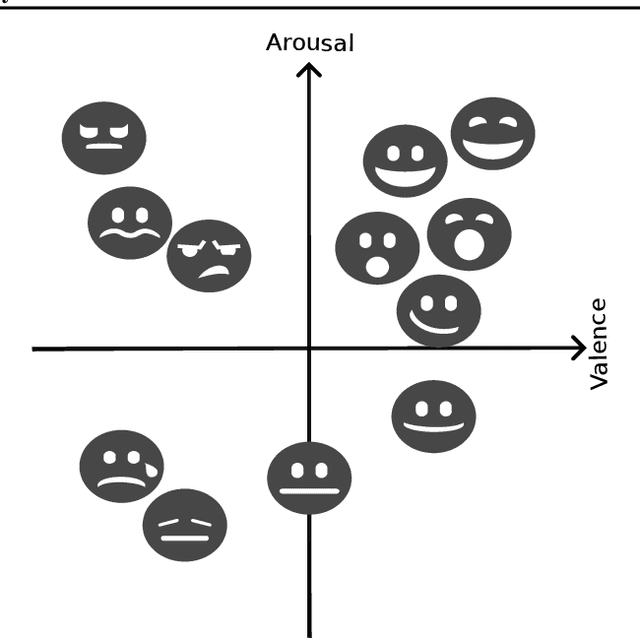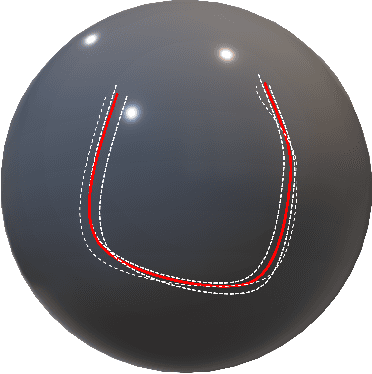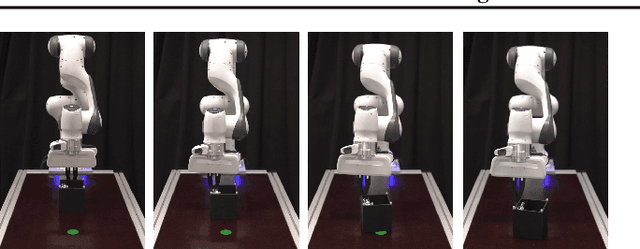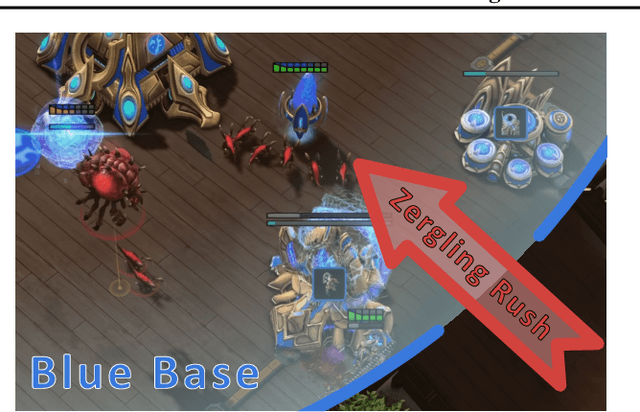Georgia Chalvatzaki
Adaptive Diffusion Constrained Sampling for Bimanual Robot Manipulation
May 21, 2025Abstract:Coordinated multi-arm manipulation requires satisfying multiple simultaneous geometric constraints across high-dimensional configuration spaces, which poses a significant challenge for traditional planning and control methods. In this work, we propose Adaptive Diffusion Constrained Sampling (ADCS), a generative framework that flexibly integrates both equality (e.g., relative and absolute pose constraints) and structured inequality constraints (e.g., proximity to object surfaces) into an energy-based diffusion model. Equality constraints are modeled using dedicated energy networks trained on pose differences in Lie algebra space, while inequality constraints are represented via Signed Distance Functions (SDFs) and encoded into learned constraint embeddings, allowing the model to reason about complex spatial regions. A key innovation of our method is a Transformer-based architecture that learns to weight constraint-specific energy functions at inference time, enabling flexible and context-aware constraint integration. Moreover, we adopt a two-phase sampling strategy that improves precision and sample diversity by combining Langevin dynamics with resampling and density-aware re-weighting. Experimental results on dual-arm manipulation tasks show that ADCS significantly improves sample diversity and generalization across settings demanding precise coordination and adaptive constraint handling.
Morphologically Symmetric Reinforcement Learning for Ambidextrous Bimanual Manipulation
May 08, 2025Abstract:Humans naturally exhibit bilateral symmetry in their gross manipulation skills, effortlessly mirroring simple actions between left and right hands. Bimanual robots-which also feature bilateral symmetry-should similarly exploit this property to perform tasks with either hand. Unlike humans, who often favor a dominant hand for fine dexterous skills, robots should ideally execute ambidextrous manipulation with equal proficiency. To this end, we introduce SYMDEX (SYMmetric DEXterity), a reinforcement learning framework for ambidextrous bi-manipulation that leverages the robot's inherent bilateral symmetry as an inductive bias. SYMDEX decomposes complex bimanual manipulation tasks into per-hand subtasks and trains dedicated policies for each. By exploiting bilateral symmetry via equivariant neural networks, experience from one arm is inherently leveraged by the opposite arm. We then distill the subtask policies into a global ambidextrous policy that is independent of the hand-task assignment. We evaluate SYMDEX on six challenging simulated manipulation tasks and demonstrate successful real-world deployment on two of them. Our approach strongly outperforms baselines on complex task in which the left and right hands perform different roles. We further demonstrate SYMDEX's scalability by extending it to a four-arm manipulation setup, where our symmetry-aware policies enable effective multi-arm collaboration and coordination. Our results highlight how structural symmetry as inductive bias in policy learning enhances sample efficiency, robustness, and generalization across diverse dexterous manipulation tasks.
On the Importance of Tactile Sensing for Imitation Learning: A Case Study on Robotic Match Lighting
Apr 18, 2025Abstract:The field of robotic manipulation has advanced significantly in the last years. At the sensing level, several novel tactile sensors have been developed, capable of providing accurate contact information. On a methodological level, learning from demonstrations has proven an efficient paradigm to obtain performant robotic manipulation policies. The combination of both holds the promise to extract crucial contact-related information from the demonstration data and actively exploit it during policy rollouts. However, despite its potential, it remains an underexplored direction. This work therefore proposes a multimodal, visuotactile imitation learning framework capable of efficiently learning fast and dexterous manipulation policies. We evaluate our framework on the dynamic, contact-rich task of robotic match lighting - a task in which tactile feedback influences human manipulation performance. The experimental results show that adding tactile information into the policies significantly improves performance by over 40%, thereby underlining the importance of tactile sensing for contact-rich manipulation tasks. Project website: https://sites.google.com/view/tactile-il .
Constrained Gaussian Process Motion Planning via Stein Variational Newton Inference
Apr 07, 2025Abstract:Gaussian Process Motion Planning (GPMP) is a widely used framework for generating smooth trajectories within a limited compute time--an essential requirement in many robotic applications. However, traditional GPMP approaches often struggle with enforcing hard nonlinear constraints and rely on Maximum a Posteriori (MAP) solutions that disregard the full Bayesian posterior. This limits planning diversity and ultimately hampers decision-making. Recent efforts to integrate Stein Variational Gradient Descent (SVGD) into motion planning have shown promise in handling complex constraints. Nonetheless, these methods still face persistent challenges, such as difficulties in strictly enforcing constraints and inefficiencies when the probabilistic inference problem is poorly conditioned. To address these issues, we propose a novel constrained Stein Variational Gaussian Process Motion Planning (cSGPMP) framework, incorporating a GPMP prior specifically designed for trajectory optimization under hard constraints. Our approach improves the efficiency of particle-based inference while explicitly handling nonlinear constraints. This advancement significantly broadens the applicability of GPMP to motion planning scenarios demanding robust Bayesian inference, strict constraint adherence, and computational efficiency within a limited time. We validate our method on standard benchmarks, achieving an average success rate of 98.57% across 350 planning tasks, significantly outperforming competitive baselines. This demonstrates the ability of our method to discover and use diverse trajectory modes, enhancing flexibility and adaptability in complex environments, and delivering significant improvements over standard baselines without incurring major computational costs.
2HandedAfforder: Learning Precise Actionable Bimanual Affordances from Human Videos
Mar 13, 2025Abstract:When interacting with objects, humans effectively reason about which regions of objects are viable for an intended action, i.e., the affordance regions of the object. They can also account for subtle differences in object regions based on the task to be performed and whether one or two hands need to be used. However, current vision-based affordance prediction methods often reduce the problem to naive object part segmentation. In this work, we propose a framework for extracting affordance data from human activity video datasets. Our extracted 2HANDS dataset contains precise object affordance region segmentations and affordance class-labels as narrations of the activity performed. The data also accounts for bimanual actions, i.e., two hands co-ordinating and interacting with one or more objects. We present a VLM-based affordance prediction model, 2HandedAfforder, trained on the dataset and demonstrate superior performance over baselines in affordance region segmentation for various activities. Finally, we show that our predicted affordance regions are actionable, i.e., can be used by an agent performing a task, through demonstration in robotic manipulation scenarios.
Continual Learning Should Move Beyond Incremental Classification
Feb 17, 2025



Abstract:Continual learning (CL) is the sub-field of machine learning concerned with accumulating knowledge in dynamic environments. So far, CL research has mainly focused on incremental classification tasks, where models learn to classify new categories while retaining knowledge of previously learned ones. Here, we argue that maintaining such a focus limits both theoretical development and practical applicability of CL methods. Through a detailed analysis of concrete examples - including multi-target classification, robotics with constrained output spaces, learning in continuous task domains, and higher-level concept memorization - we demonstrate how current CL approaches often fail when applied beyond standard classification. We identify three fundamental challenges: (C1) the nature of continuity in learning problems, (C2) the choice of appropriate spaces and metrics for measuring similarity, and (C3) the role of learning objectives beyond classification. For each challenge, we provide specific recommendations to help move the field forward, including formalizing temporal dynamics through distribution processes, developing principled approaches for continuous task spaces, and incorporating density estimation and generative objectives. In so doing, this position paper aims to broaden the scope of CL research while strengthening its theoretical foundations, making it more applicable to real-world problems.
DIME:Diffusion-Based Maximum Entropy Reinforcement Learning
Feb 04, 2025Abstract:Maximum entropy reinforcement learning (MaxEnt-RL) has become the standard approach to RL due to its beneficial exploration properties. Traditionally, policies are parameterized using Gaussian distributions, which significantly limits their representational capacity. Diffusion-based policies offer a more expressive alternative, yet integrating them into MaxEnt-RL poses challenges--primarily due to the intractability of computing their marginal entropy. To overcome this, we propose Diffusion-Based Maximum Entropy RL (DIME). DIME leverages recent advances in approximate inference with diffusion models to derive a lower bound on the maximum entropy objective. Additionally, we propose a policy iteration scheme that provably converges to the optimal diffusion policy. Our method enables the use of expressive diffusion-based policies while retaining the principled exploration benefits of MaxEnt-RL, significantly outperforming other diffusion-based methods on challenging high-dimensional control benchmarks. It is also competitive with state-of-the-art non-diffusion based RL methods while requiring fewer algorithmic design choices and smaller update-to-data ratios, reducing computational complexity.
6DOPE-GS: Online 6D Object Pose Estimation using Gaussian Splatting
Dec 02, 2024Abstract:Efficient and accurate object pose estimation is an essential component for modern vision systems in many applications such as Augmented Reality, autonomous driving, and robotics. While research in model-based 6D object pose estimation has delivered promising results, model-free methods are hindered by the high computational load in rendering and inferring consistent poses of arbitrary objects in a live RGB-D video stream. To address this issue, we present 6DOPE-GS, a novel method for online 6D object pose estimation \& tracking with a single RGB-D camera by effectively leveraging advances in Gaussian Splatting. Thanks to the fast differentiable rendering capabilities of Gaussian Splatting, 6DOPE-GS can simultaneously optimize for 6D object poses and 3D object reconstruction. To achieve the necessary efficiency and accuracy for live tracking, our method uses incremental 2D Gaussian Splatting with an intelligent dynamic keyframe selection procedure to achieve high spatial object coverage and prevent erroneous pose updates. We also propose an opacity statistic-based pruning mechanism for adaptive Gaussian density control, to ensure training stability and efficiency. We evaluate our method on the HO3D and YCBInEOAT datasets and show that 6DOPE-GS matches the performance of state-of-the-art baselines for model-free simultaneous 6D pose tracking and reconstruction while providing a 5$\times$ speedup. We also demonstrate the method's suitability for live, dynamic object tracking and reconstruction in a real-world setting.
Global Tensor Motion Planning
Nov 28, 2024Abstract:Batch planning is increasingly crucial for the scalability of robotics tasks and dataset generation diversity. This paper presents Global Tensor Motion Planning (GTMP) -- a sampling-based motion planning algorithm comprising only tensor operations. We introduce a novel discretization structure represented as a random multipartite graph, enabling efficient vectorized sampling, collision checking, and search. We provide an early theoretical investigation showing that GTMP exhibits probabilistic completeness while supporting modern GPU/TPU. Additionally, by incorporating smooth structures into the multipartite graph, GTMP directly plans smooth splines without requiring gradient-based optimization. Experiments on lidar-scanned occupancy maps and the MotionBenchMarker dataset demonstrate GTMP's computation efficiency in batch planning compared to baselines, underscoring GTMP's potential as a robust, scalable planner for diverse applications and large-scale robot learning tasks.
Safe and Efficient Path Planning under Uncertainty via Deep Collision Probability Fields
Sep 06, 2024



Abstract:Estimating collision probabilities between robots and environmental obstacles or other moving agents is crucial to ensure safety during path planning. This is an important building block of modern planning algorithms in many application scenarios such as autonomous driving, where noisy sensors perceive obstacles. While many approaches exist, they either provide too conservative estimates of the collision probabilities or are computationally intensive due to their sampling-based nature. To deal with these issues, we introduce Deep Collision Probability Fields, a neural-based approach for computing collision probabilities of arbitrary objects with arbitrary unimodal uncertainty distributions. Our approach relegates the computationally intensive estimation of collision probabilities via sampling at the training step, allowing for fast neural network inference of the constraints during planning. In extensive experiments, we show that Deep Collision Probability Fields can produce reasonably accurate collision probabilities (up to 10^{-3}) for planning and that our approach can be easily plugged into standard path planning approaches to plan safe paths on 2-D maps containing uncertain static and dynamic obstacles. Additional material, code, and videos are available at https://sites.google.com/view/ral-dcpf.
 Add to Chrome
Add to Chrome Add to Firefox
Add to Firefox Add to Edge
Add to Edge